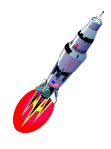Science College, General Science Dept
Good morning CLAW students! Welcome to our class on the Solar System. We are Jazzy Taylor and Razz Poisson, your teachers for this class. We are very glad you decided to spend some time with us today and learn about the Solar System. The Solar System is comprised of the Sun and nine major planets.
The center of our Solar System is the Sun. The word "Solar" means "of the sun." The Sun is actually a star, not a planet. Our Sun is just like the stars we see in the night sky. The Sun is the only star we see during the day. The Sun is so big that you could fit more than 1 million earths inside of it! It measures more than a million kilometers
across.
The Sun is so hot that planets millions of kilometers away can feel its heat!
The Sun is about 75% hydrogen and 25% helium. This changes slowly over time as the Sun converts hydrogen to helium in its core.
The source of the Sun's energy comes from nuclear reactions that occur deep within its core. It generates 386 billion billion megawatts of energy!The Solar System can be divided into two groups, the inner planets and the outer planets. The inner planets, the ones closest to the Sun, are Mercury, Venus, Earth and Mars. The outer planets are Jupiter, Saturn, Uranus, Neptune and Pluto. A large group of asteroids, the Asteroid Belt, is located between the inner and the outer solar systems.
The inner planets are rocky planets, being made up of mostly rock and metal. These planets are all small but very heavy, move slowly, have no rings and very few moons. Pluto is also a rocky planet.
The outer planets, except for Pluto, are gas planets, mostly made up of gases. These planets are very light for their size and move more quickly. They all have rings and many moons. They are also called the Giant Planets, because of their very large size.
Click on the spaceship to travel to the planets.[Exam]


